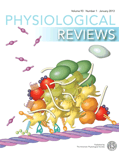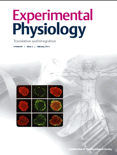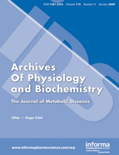
Physiological Reviews
Scope & Guideline
Transforming Research into Comprehensive Reviews
Introduction
Aims and Scopes
- Cardiovascular Physiology:
Explores mechanisms of cardiac function, ion channel regulation, and the pathophysiology of cardiovascular diseases, highlighting advancements in treatment strategies and molecular insights. - Neurophysiology:
Investigates the neurobiological underpinnings of behavior, sensory processing, and neurological disorders, addressing both cellular mechanisms and systemic implications. - Metabolic and Endocrine Physiology:
Analyzes hormonal regulation, metabolic pathways, and their impacts on health and disease, particularly in relation to conditions such as diabetes and obesity. - Respiratory Physiology:
Focuses on the mechanics of respiration, the role of the microbiome in respiratory health, and the physiological responses to environmental stressors like climate change. - Physiology of Aging and Disease:
Reviews the physiological changes associated with aging and the development of age-related diseases, emphasizing the importance of lifestyle factors and therapeutic interventions. - Systems Biology Approaches:
Utilizes integrative frameworks to understand complex physiological systems, including the interaction of various biological pathways and their implications in health and disease.
Trending and Emerging
- Impact of COVID-19 on Physiology:
A significant increase in publications addressing the physiological implications of COVID-19, including its effects on multiple organ systems, immune response, and long-term health outcomes. - Artificial Intelligence in Health Care:
Emerging discussions surrounding the integration of AI in physiological research and healthcare delivery, emphasizing its potential for improving diagnostics and treatment strategies. - Microbiome and Health:
A growing emphasis on the role of the microbiome in various physiological processes, particularly its influence on immune function and metabolic health. - Stress Physiology and Resilience:
Research focusing on the neurobiology and systems biology of stress resilience is gaining traction, reflecting increased interest in mental health and its physiological connections. - Translational and Regenerative Medicine:
A rising trend in studies related to regenerative therapies, including stem cell research and tissue engineering, particularly in the context of cardiovascular and metabolic diseases.
Declining or Waning
- Obesity and Cardiomyopathy:
Although still relevant, the specific focus on obesity-related cardiac issues has seen a decrease, possibly due to a saturation of existing knowledge and a shift towards broader metabolic studies. - Traditional Endocrinology:
Classic topics in endocrinology are being overshadowed by newer insights into metabolic physiology and the role of emerging technologies, such as artificial intelligence in healthcare. - Basic Mechanistic Studies of Exercise Physiology:
While exercise physiology remains important, there is a noticeable decline in purely mechanistic studies, with a shift towards applied and translational research that connects exercise to health outcomes. - Single-Organ Studies:
Research focusing exclusively on single-organ systems (e.g., liver or kidney) is becoming less common as integrated physiological approaches gain traction, emphasizing the interconnectedness of body systems.
Similar Journals

EXPERIMENTAL PHYSIOLOGY
Shaping the future of Nutrition and Physiology research.EXPERIMENTAL PHYSIOLOGY, published by WILEY, stands as a vital resource in the fields of Nutrition and Dietetics and Physiology, providing high-quality, peer-reviewed research since its inception in 1990. With an impressive categorization into the Q2 quartile in these domains, the journal emphasizes the integration of experimental and clinical findings, making significant contributions to our understanding of physiological processes and nutritional impacts on health. The journal operates within a competitive landscape, ranked significantly in Scopus, showcasing its relevance to both the medical community and nutritional sciences, as evidenced by its rankings in Nursing, Medicine, and Biochemistry. Though it is not currently open access, the journal remains an indispensable tool for researchers, professionals, and students seeking to deepen their knowledge and stay updated on cutting-edge research. With a publication window extending to 2024, EXPERIMENTAL PHYSIOLOGY continues to influence the academic discourse and promote advancements in its respective fields.

Function
Pioneering discoveries that drive the evolution of healthcare.Function is a pioneering open access academic journal published by Oxford University Press, dedicated to advancing research in the fields of Cancer Research, Cell Biology, Molecular Medicine, and Physiology. Since its inception in 2020, this journal has quickly established itself as a vital resource for researchers and professionals alike, achieving a commendable impact factor in the 2023 rankings, where it stands in the Q2 quartile across multiple categories. Located in the heart of the United Kingdom, Function aims to foster a global exchange of knowledge by providing free and unrestricted access to cutting-edge research, facilitating collaboration and innovation within the scientific community. With a robust focus on emerging discoveries and interdisciplinary approaches, this journal encourages contributions that unravel the complexities of biological functions, paving the way for transformative advancements in healthcare and related sciences. As it converges from 2020 to 2024, Function continues to be an invaluable platform for disseminating research that has the potential to shape the future of medicine and biology.

JOURNAL OF PHYSIOLOGY AND BIOCHEMISTRY
Fostering Collaborative Discoveries in Biomedical ResearchJOURNAL OF PHYSIOLOGY AND BIOCHEMISTRY, published by Springer in the Netherlands, serves as a pivotal platform for disseminating high-quality research within the fields of physiology, biochemistry, and related biomedical sciences. With an impressive impact factor reflected in its categorization as Q2 in Biochemistry and Q1 in Medicine (miscellaneous), this journal fosters a vibrant community of scholars dedicated to advancing knowledge and innovation. The journal’s broad scope encompasses a wide range of topics from cellular mechanisms to systemic physiology, making it relevant for both theoretical and applied sciences. Researchers and practitioners are encouraged to utilize the available Open Access options to reach a wider audience. The journal’s continuous contribution to the scientific dialogue since its inception in 1996 positions it as a key resource for professionals and students alike, facilitating the exploration of cutting-edge topics and collaborative research opportunities.

Current Opinion in Physiology
Shaping Tomorrow’s Understanding of PhysiologyCurrent Opinion in Physiology, published by Elsevier, is a leading journal dedicated to the dynamic field of physiology. With an E-ISSN of 2468-8673, this journal provides a platform for the latest insights and perspectives, reflecting the evolving landscape of physiological research. Operating from the United Kingdom, the journal holds a respectable impact factor and is ranked Q2 in both general physiology and medical physiology categories, highlighting its prominence among the global academic community. With Scopus rankings placing it in the 64th and 60th percentiles within its respective categories, Current Opinion in Physiology serves as an essential resource for researchers, professionals, and students eager to stay informed about innovative theories and emerging trends in physiology. The publication emphasizes high-quality reviews that summarize current knowledge and future directions, ensuring readers gain valuable insights applicable in both clinical and research settings.

RESPIRATORY PHYSIOLOGY & NEUROBIOLOGY
Advancing Insights in Respiratory and Neural DynamicsRESPIRATORY PHYSIOLOGY & NEUROBIOLOGY, published by Elsevier, is a prominent journal in the fields of respiratory medicine, neurobiology, and physiology. With an ISSN of 1569-9048 and E-ISSN 1878-1519, this journal serves as an essential platform for disseminating high-quality original research and reviews that explore the intricate relationships between respiratory function and neural controls. Located in the Netherlands, it boasts an impressive standing within its field, categorically placed in the Q3 quartile for Neuroscience and Physiology and Q2 for Pulmonary and Respiratory Medicine according to the 2023 metrics. With a Scopus rank of #58 in Pulmonary and Respiratory Medicine and a robust impact factor indicative of its academic influence, the journal aims to foster advancement in understanding the physiological and neurobiological aspects of respiration. Although the journal is not open access, its content is vital for researchers, professionals, and students eager to contribute to the expanding knowledge base in these critical scientific domains.

Frontiers in Physiology
Transforming understanding of physiological processes.Frontiers in Physiology, published by FRONTIERS MEDIA SA, is a leading open-access journal that has been at the forefront of physiological research since its inception in 2010. As a reputable publication based in Switzerland, it aims to foster the dissemination of groundbreaking findings across various domains of physiology, engaging a global audience of scholars and practitioners. With a commendable Q2 ranking in the fields of both general physiology and medical physiology for 2023, this journal stands out in its field, achieving a significant Scopus rank of #32/113 in medical physiology and #58/193 in biochemistry, genetics, and molecular biology. Frontiers in Physiology not only commits to maintaining high scholarly standards but also ensures that all its articles are freely accessible, thereby promoting collaborative knowledge exchange. With a clear focus on advancing our understanding of physiological processes, the journal plays a crucial role in the development of innovative approaches to health and disease, making it an essential resource for researchers, professionals, and students alike.

ARCHIVES OF PHYSIOLOGY AND BIOCHEMISTRY
Empowering Researchers with Cutting-Edge DiscoveriesArchives of Physiology and Biochemistry, published by Taylor & Francis Ltd, is a renowned journal that has been pivotal in advancing knowledge and research in the fields of physiology and biochemistry since its inception. With an impact factor reflective of its significant contributions, this journal is categorized in Q2 in Medicine (miscellaneous) and Q3 in Physiology, underscoring its relevance and scholarly impact within the scientific community. The journal publishes original research articles, review papers, and innovative methodologies that explore the intricate relationships between physiological functions and biochemical processes. With its commitment to fostering scientific discourse, the Archives of Physiology and Biochemistry serves as an essential resource for researchers, professionals, and students alike, providing insights and evidence that drive forward the frontiers of medical and physiological science. The journal is accessible in both print and online formats, ensuring that critical research reaches a wide audience.

Comprehensive Physiology
Pioneering Insights into Physiological MechanismsComprehensive Physiology is a premier journal published by WILEY, dedicated to the profound exploration of physiological science. With an impact factor that underscores its significance within the field, this journal serves as a pivotal resource for researchers, professionals, and students alike, ensuring access to cutting-edge studies and reviews that span various domains of physiology. It stands proudly in the Q1 category across multiple subfields including Medicine (miscellaneous), Physiology, and Medical Physiology, reflecting its outstanding position within the scientific community. Evaluated within prestigious bibliometric ranks, it boasts an impressive Scopus ranking, placing it in the 12th percentile for medical physiology and 23rd percentile in biochemical, genetic, and molecular physiology. As it converges from 2011 to 2024, Comprehensive Physiology continues to foster a platform for innovative discoveries and collaborative exchanges, thereby contributing significantly to the advancement of medical knowledge and understanding of physiological processes.

Physiology International
Elevating Standards in Physiological ResearchPhysiology International is a distinguished journal dedicated to the exploration and advancement of knowledge in the fields of physiology, sports medicine, and rehabilitation. Published by AKADEMIAI KIADO ZRT in Hungary, this open-access journal has been a reliable source of scholarly articles since its inception in 2016, providing valuable insights into both complementary and alternative medicine, as well as traditional medical practices. With an impact factor that situates it in Q2 and Q3 quartiles across related disciplines, including Physical Therapy, Sports Therapy and Rehabilitation and Orthopedics and Sports Medicine, it represents a vital resource for professionals and researchers looking to stay abreast of the latest findings and methodologies. The journal is indexed on Scopus, signifying its credibility and relevance in the medical community. As it continues to develop through 2024, Physiology International invites contributions that challenge existing paradigms and foster innovative approaches to health and wellness, making it an essential platform for advancing the conversation in medical physiology and its applications.

CHINESE JOURNAL OF PHYSIOLOGY
Pioneering insights in physiology since 1971.CHINESE JOURNAL OF PHYSIOLOGY, published by WOLTERS KLUWER MEDKNOW PUBLICATIONS, has been a vital resource since its inception in 1971, catering to the expansive field of physiology. Operating out of Taiwan, this journal addresses critical research in both general and medical physiology, providing a platform for innovative studies that contribute significantly to the understanding of biological processes. With an emphasis on disseminating high-quality, peer-reviewed articles, it holds a Q4 ranking in Physiology and a Q3 ranking in Medical Physiology as of 2023, reflecting its commitment to advancing physiological science. The ISSN for this journal is 0304-4920 and the E-ISSN is 2666-0059. While access options are not available as open access, researchers and professionals can still benefit from its valuable insights. Notably, it ranks #78/113 in Medicine - Physiology and #159/193 in Biochemistry, Genetics, and Molecular Biology - Physiology on Scopus, indicating its growing influence in the scientific community. We invite researchers, professionals, and students alike to explore the wealth of knowledge featured within the pages of the CHINESE JOURNAL OF PHYSIOLOGY.